That’s where the best email verification software API changes the game, allowing sales and marketing teams to check every address at speed, in bulk, and even before it hits your database.
From real-time web forms and CRM syncs to massive pre-campaign list cleaning, we’ll explore what a world-class email verification API can do, how it works, and how top platforms (with Bouncer leading the pack) are helping businesses protect sender reputation, optimize campaign results, and never fear a bounce again.
TL;DR
- The right email verification API stops bad addresses at the source with real-time checks, bulk processing, and deep validation—including disposable, catch-all, and spam-trap detection.
- Enterprise APIs should deliver rich results, async batch endpoints, strong security (GDPR/SOC2), clean documentation, and easy integrations with CRMs, ESPs, and Google Sheets.
- Bouncer leads this category with fast, scalable verification, advanced risk signals, EU-hosted security, and developer-friendly tooling—outperforming more limited or pricier alternatives.
Why use an email verification API?
API-powered email verification is not just for tech teams. Today’s top APIs are built for everyone (marketing and sales teams, developers, product managers) who are serious about data quality and inbox placement.
Here’s why it’s become the standard:
- Real-time validation: Instantly verify emails in web forms, sign-up flows, or CRM imports. Stop syntax errors, typos, and risky addresses before they ever hit your system.
- Bulk upload & batch verification: Run entire lists—hundreds of thousands of emails—through a single endpoint. No more manual checking.
- Seamless automation: Trigger verification automatically when a user registers, when you schedule a campaign, or via Google Sheets for ongoing list hygiene.
- Flexible pricing: Most providers (like Bouncer) offer pay as you go or monthly subscription options—perfect for both free users and enterprise giants.
- Custom workflows: APIs can plug into any stack: eCommerce, SaaS, lead-gen, marketplaces, even internal databases.
Want to see what’s possible? Explore Bouncer’s API capabilities and start for free.
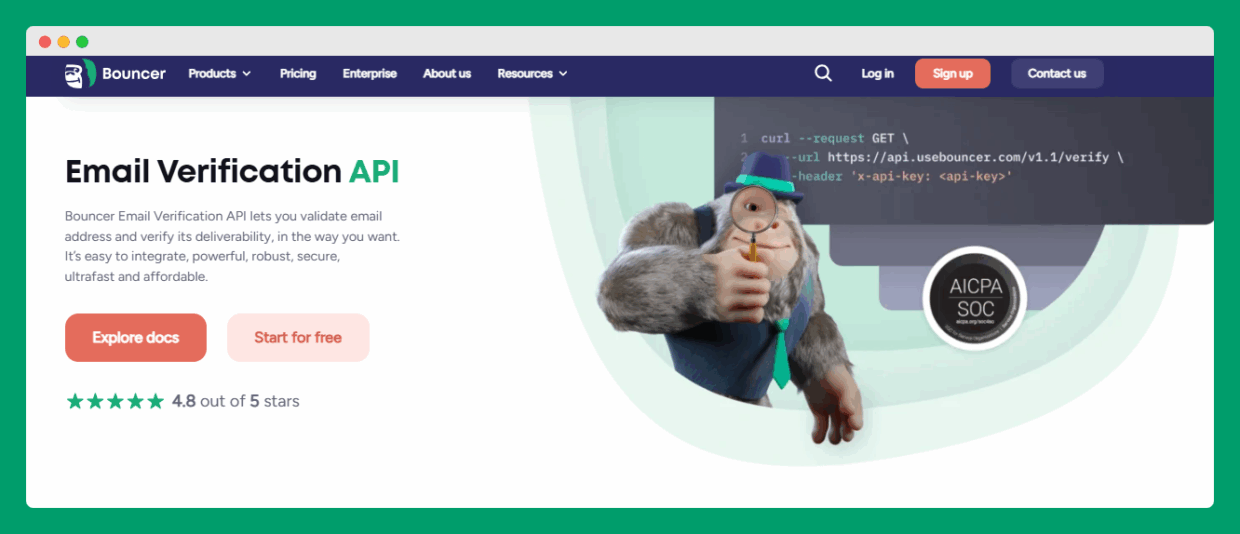
What makes the best email verification software API?
Not all email verification APIs are created equal.
The true market leaders combine enterprise-grade speed, flexible endpoints, bulletproof security, and a developer experience that doesn’t make you want to pull your hair out.
When choosing a provider, look for:
- High accuracy – Deep validation—syntax, domain, MX, mailbox existence, spam traps, disposable email address, catch all, and even role-based or business-only checks.
- Scalable endpoints – Both synchronous (real-time) and asynchronous (batch/bulk) API calls.
- Developer experience – Clean, well-structured API documentation, robust error handling, fast support, and clear versioning.
- Detailed reports – Every call should return not just “valid/invalid,” but actionable fields—reason, risk, source, deliverability score, mailbox flags, provider, and more.
- Data protection regulations – Compliance with GDPR, CCPA, and hosting in secure data centers (like Bouncer’s AWS EU infrastructure).
- Flexible pricing – Pay as you go, generous free credits, and simple cost structures that scale with you.
- Integration – Plug into email marketing tools, CRMs, data warehouses, or even directly to Google Sheets via add-ons.
Want to see these standards in action?
Bouncer’s Deliverability Kit is a masterclass on going beyond “good enough” and optimizing every layer of deliverability.

Bulk email verification: API-driven list cleaning at scale
Bulk is where the best APIs shine.
Instead of slogging through uploads or one-by-one checks, you can bulk verify email addresses—from onboarding, to CRM sync, to pre-campaign scrubs:
- Batch verification endpoints: Upload and verify up to hundreds of thousands of addresses per request.
- Bulk email validation: Remove duplicate emails, flag disposable email addresses, and detect spam traps in a single call.
- Async support: Don’t wait for slow responses—get notified when jobs finish, or pull results on demand.
- Detailed results: Get not just “valid/invalid,” but explanations for bounces, warnings for risky domains, and indicators for “unknown” or “catch all” outcomes.
Check how Bouncer’s integrations handle bulk uploads for all major platforms.

Email addresses: What your API should check (and why it matters)
A best-in-class email verification API goes well beyond a syntax check:
- Domain name validity: Is the domain real, active, and configured to receive mail?
- MX/Syntax: Catch typos, fake TLDs, malformed addresses, and invalid emails.
- Mailbox existence: Does the mailbox really exist? (No more dead mailboxes.)
- Spam traps: Proactively block known bad addresses that tank deliverability.
- Disposable email: Detect addresses from popular disposable email providers.
- Catch all: Flag tricky domains that “accept everything” but don’t deliver.
- Role-based/business: Filter for professional email addresses or weed out “info@” and “sales@” as needed.
- Temporary email address: Guard against one-time or burner emails polluting your data.
Bouncer Shield is a standout for deep detection—catch-all, anti-spam, niche provider coverage, and more. And if you want to identify toxic, disposable, or malicious emails, explore our Toxicity Check.
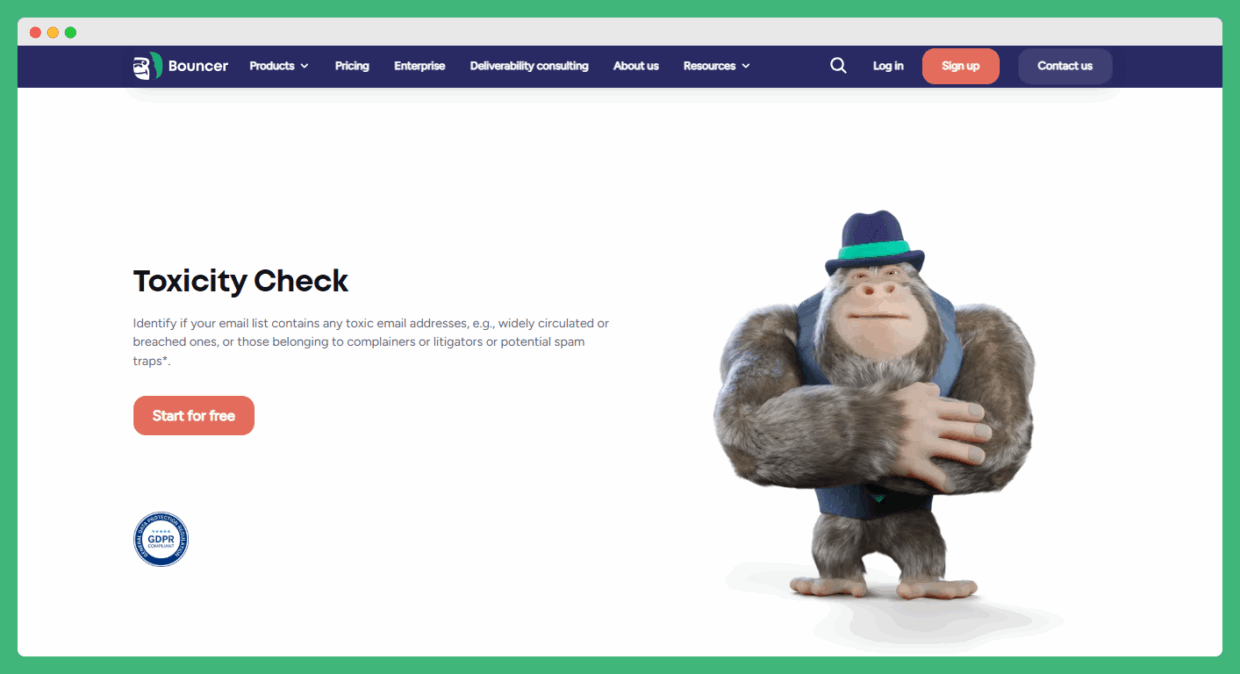
Bulk email verifier: Real-world use cases
What does bulk verification via API look like in the wild?
- Email marketing efforts: Clean every list before a send—massively reduce bounces, keep sender reputation high.
- Registration/sign-up validation: Real-time or batch, prevent bad data from entering your ecosystem at all.
- CRM hygiene: Regularly validate user databases, auto-flagging for re-engagement or suppression.
- Lead enrichment and scoring: Combine an email finder API with validation for quality prospecting.
- Google Sheets add on: Enable non-developers to automate checks in spreadsheets for ongoing maintenance.
Here’s how Bouncer handles bulk uploads and batch processing for both devs and marketers.
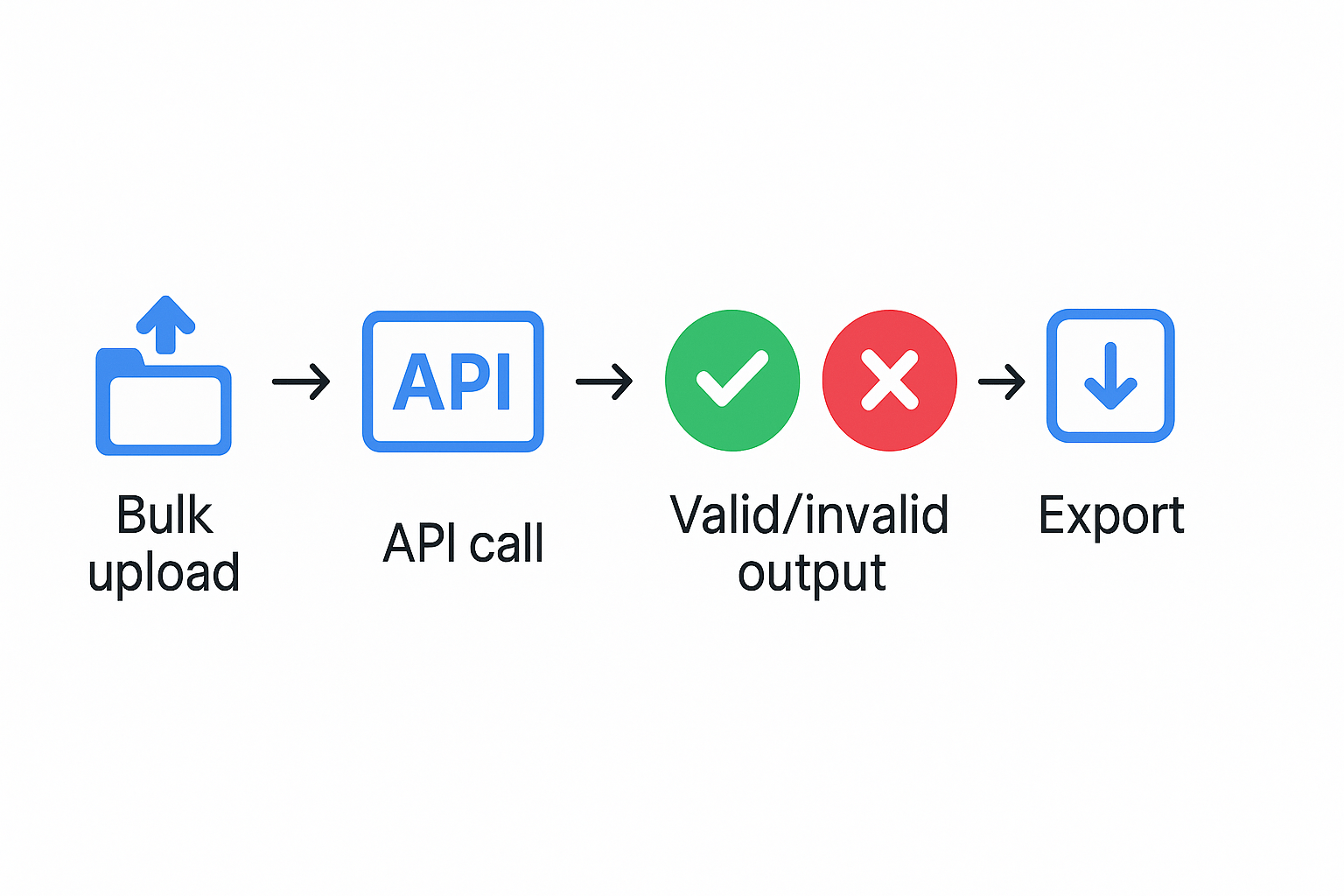
Email deliverability: Your API’s secret weapon
Email deliverability is the difference between “sent” and “seen.” If your emails are flagged as spam, bounce, or hit traps, your brand reputation (and ROI) suffer. The right API helps you:
- Slash bounce rates by validating all email addresses (before a campaign or in real time)
- Block spam traps and risky addresses, protecting email reputation
- Monitor deliverability trends, adjust suppression lists, and catch infrastructure issues
- Meet the standards of email service providers for inbox placement
Looking to optimize every layer? Bouncer’s Deliverability Kit is a must-have resource.
Email address verification: Going beyond “valid/invalid”
A modern email verification service returns much more than a binary result:
- Mailbox existence and status: Is the mailbox deliverable? Full? Unknown?
- Reason codes: Get actionable feedback (e.g., “domain does not exist,” “mailbox full,” “greylisted,” etc.).
- Risk scoring: Which emails are risky, unverified, or linked to spam complaints?
- Free vs. business address detection: Perfect for B2B-focused teams that want to block free email providers at sign-up.
With Bouncer’s API (see details here), you can verify emails with confidence—real-time or in bulk, with detailed flags for every scenario.
Email address validation: Enrichment and future-proofing
Great APIs don’t just say “yes or no.” They enrich your database and streamline downstream workflows:
- Email finder integration: Discover, validate, and enrich leads in one flow.
- Segment by provider, business, free, disposable: Target better, personalize campaigns, and avoid wasted sends.
- Flexible output: Detailed status, enrichment fields, and actionable data for every api request.
- Compliance: Support for data protection regulations and full audit trails.
Bouncer’s Data Enrichment adds context to every address and makes your CRM or marketing automation smarter.
Best email verification tool: Comparing top API providers
Choosing the best email verification software API isn’t about picking the most popular name or the flashiest landing page.
For technical buyers and business leaders alike, the real question is: Which tool delivers the most value, reliability, and future-proof features for your workflow, compliance, and scale?
Below, we take a closer look at the most prominent API-driven email verification solutions on the market, with a special focus on what matters to real-world users: speed, coverage, accuracy, developer experience, integration, and business results.
Bouncer API: The high bar for accuracy, scalability, and user experience
Bouncer’s API is widely regarded as the best email verification software API for ambitious, data-driven organizations and SaaS teams.
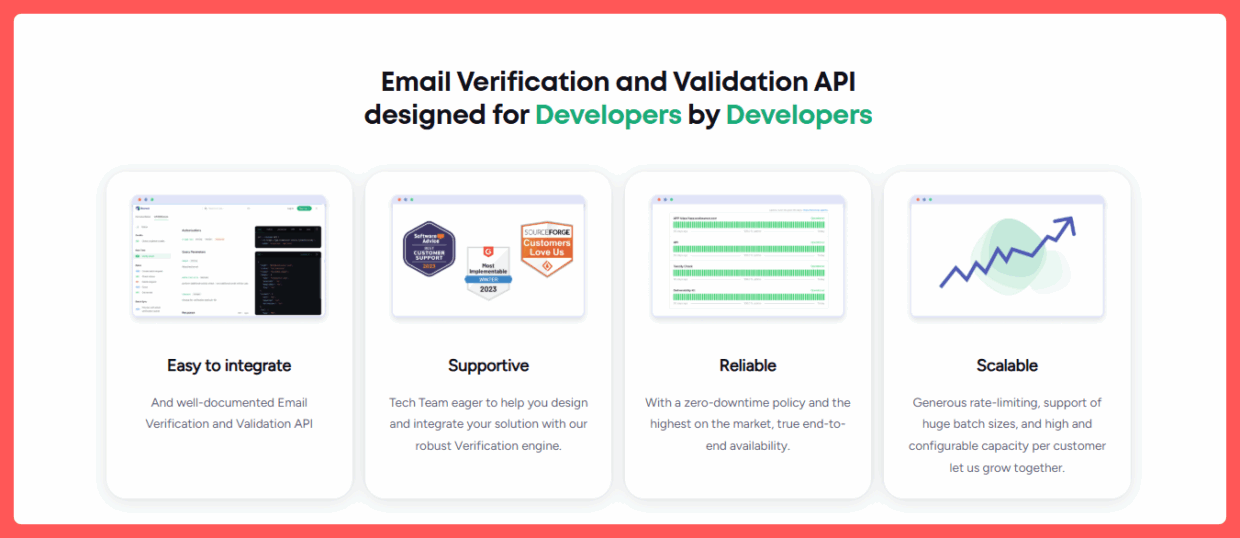
What makes Bouncer stand out?
- Enterprise-grade batch verification: Handle up to 500,000 addresses in one call, with asynchronous processing, progress tracking, and webhook support. You can reliably bulk verify email addresses—no timeouts, no dropped data, and a recommended chunking strategy for massive uploads.
- Lightning-fast real-time API: Instantly validate emails in sign-up forms, transactional emails, or CRM imports. API calls typically return in milliseconds, supporting both single and bulk endpoints.
- Advanced deliverability protection: Proprietary algorithms and deep checks (Bouncer Shield and Toxicity Check) detect spam traps, catch-all, role accounts, business vs. free, and disposable email providers. This dramatically lowers bounce rates and keeps sender reputation intact.
- World-class security: Fully GDPR-compliant, all data hosted in AWS EU, and military grade data encryption. Every API key is protected, and you control data retention or removal—ideal for regulated industries.
- Rich, actionable output: Don’t settle for “valid/invalid.” Bouncer’s API response includes granular status (deliverable, undeliverable, risky, unknown), reason codes, toxicity flags, mailbox and domain insights, enrichment fields, and role/free/disposable flags—making it easier to automate workflows and decision-making.
- Top developer experience: API documentation is praised for clarity, real-world code samples, sandbox/test modes, versioning, and dedicated support for implementation (video, chat, email).
- Unmatched support: Get instant help from actual technical specialists who know the product inside out—no generic ticket queues.
- Flexible, fair pricing: Start free, with generous credits, then scale via pay-as-you-go or enterprise agreements. You only pay for what you use.
- Native integrations: Prebuilt connections to Google Sheets, Zapier, CRMs, and every major email service provider (all integrations).
- Reliability: 100% uptime and <2% unknowns—among the lowest in the market.
- Continuous improvement: Frequent feature releases, security upgrades, and responsive feedback to customer needs.
Who should choose the Bouncer API?
Teams that care about deliverability, need to bulk verify emails, want deep output for automation or reporting, or require strict data protection for compliance.
If you want an API that grows with your business—handling everything from small web forms to enterprise-scale marketing and sales teams—Bouncer is hard to beat.

ZeroBounce API: Comprehensive but costlier for high volume
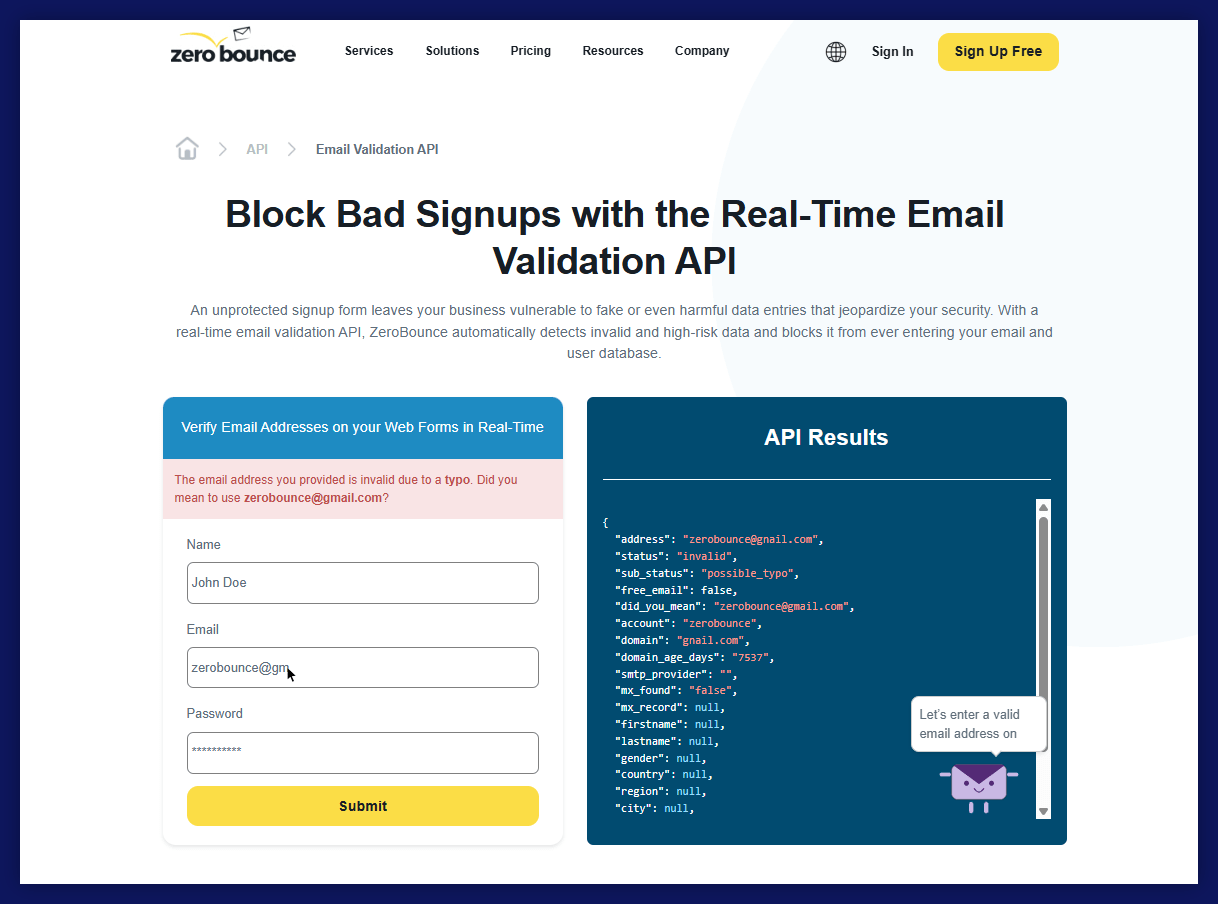
ZeroBounce‘s API is a solid choice, especially for businesses focused on analytics, blacklist monitoring, and deliverability.
- Feature set: Covers all basics—syntax, domain, mailbox, spam traps, disposable detection—plus extras like blacklist monitoring.
- Analytics focus: Strong dashboard for reporting and integration with marketing automation tools.
- API experience: Clean, modern interface; decent real-time speed; solid batch processing.
- Pricing: Free tier available, but pricing climbs quickly for bulk usage (watch for overage fees).
- Limitations: Not so cheap. Documentation is robust but can feel more “enterprise” and less hands-on.
Who is it for?
Teams with advanced analytics needs, willing to pay a premium for features like blacklist/IP reputation, but may not need the granularity or batch flexibility Bouncer provides.
NeverBounce API: Fast, friendly, but limited enrichment
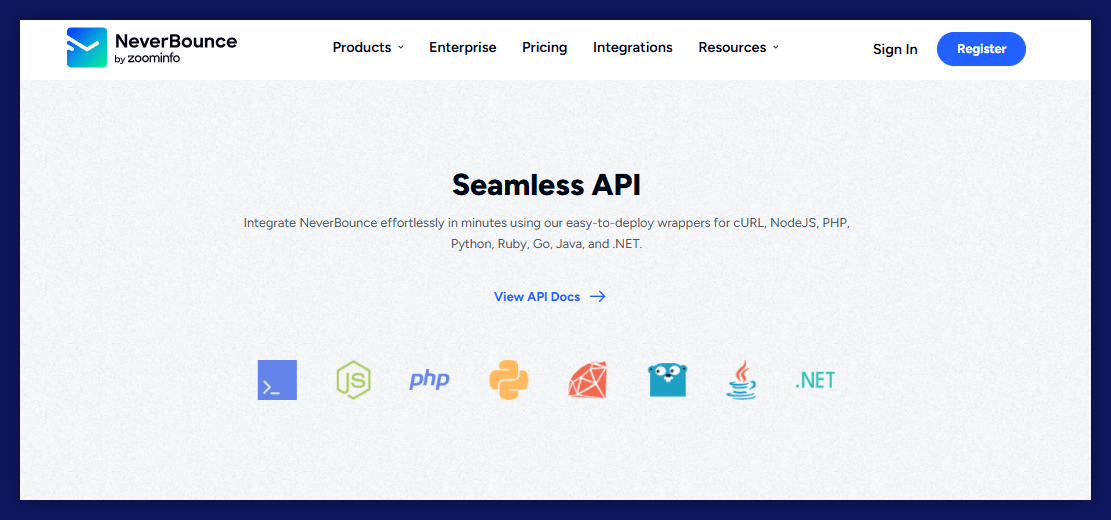
NeverBounce‘s API is popular with agencies and small businesses due to its simplicity and speed.
- Batch and real-time: Both supported, with good throughput and easy-to-understand responses.
- UI/UX: Modern, straightforward dashboard; easy to test and get started.
- Output: Covers all major validation points (syntax, domain, mailbox, disposable, etc.), but advanced output is less detailed than Bouncer’s (e.g., lacks toxicity scoring, bounce shield).
- Integrations: Many direct integrations with ESPs and marketing tools; Google Sheets support available.
- Pricing: Flexible, two models, pay as you go rates.
- Limitations: Accuracy and support problems, quite expensive.
Best for:
Startups, agencies that need fast validation but don’t require rich data or advanced automation.
Kickbox API: Reliable and simple, but basic output
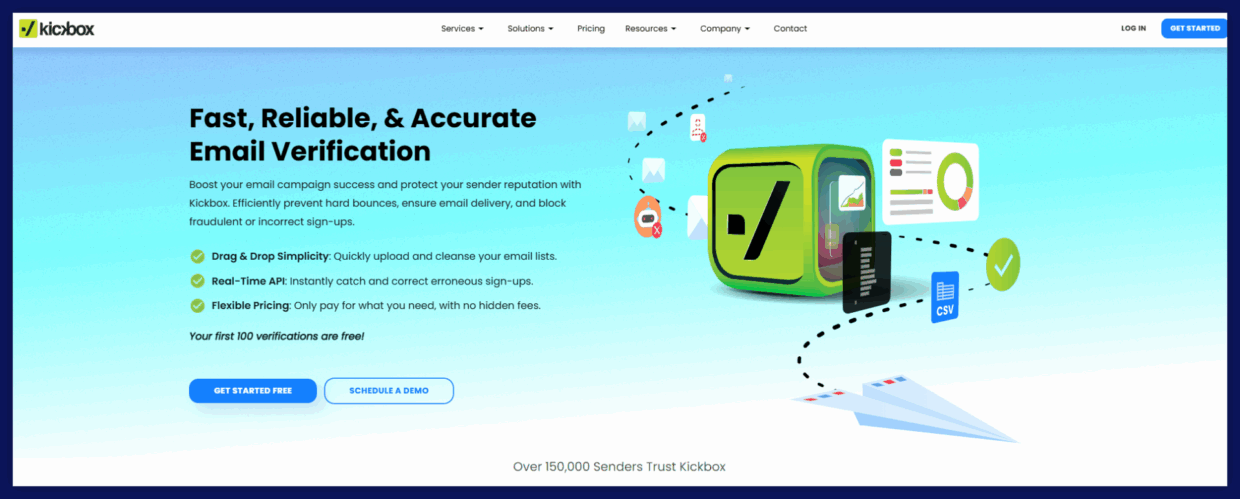
Kickbox is a staple in the space, known for stability and ease of use.
- Real-time and batch: Easy to set up, minimal learning curve, stable for everyday use.
- Documentation: Well-written, clean, with code samples.
- Output: Covers main deliverability signals (valid, risky, undeliverable, disposable, role), but doesn’t go deep on scoring, toxicity, or advanced enrichment.
- Integrations: Supports major ESPs, CRM, and some marketing platforms.
- Pricing: Transparent, with free trial credits.
- Limitations: Some accuracy problems, UI feels outdated, limited insights into email classification.
Best for:
Teams wanting fast onboarding, stable results, and integration with existing marketing tools, but with fewer “power user” features.
Hunter.io API: Best for prospecting, less for bulk hygiene
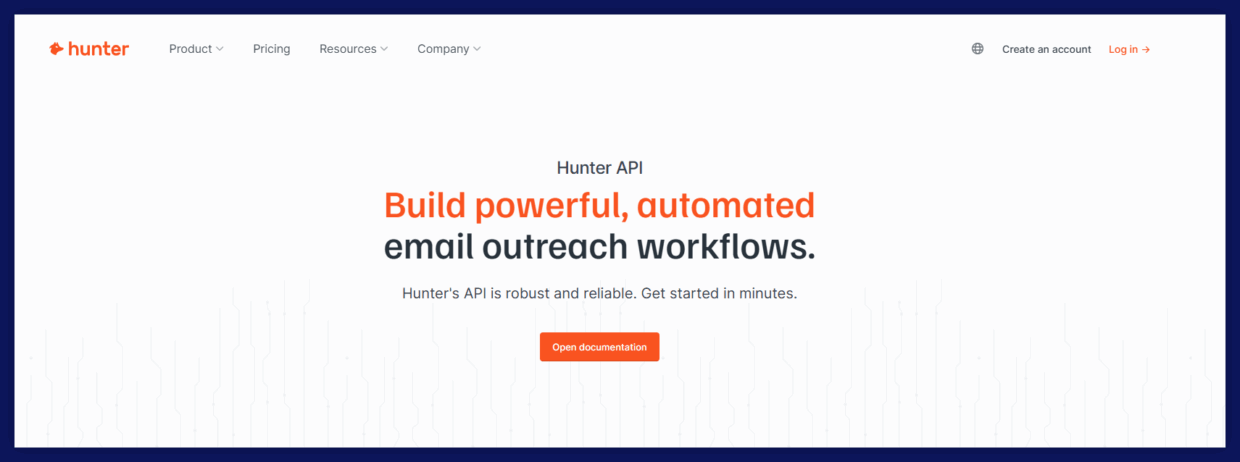
Hunter is famous for its email finder capability, but its API also offers validation.
- Email finding and verification: Especially strong for B2B prospecting and lead-gen use cases.
- Batch support: Good for small to medium lists; less suited to massive uploads.
- Output: Basic (valid, invalid, disposable, webmail), but not as nuanced or detailed as Bouncer.
- Integrations: Best in class for LinkedIn/email enrichment; Google Sheets add-on available.
- Limitations: Not designed for deep hygiene, scoring, or bulk deliverability optimization.
Who is it for?
Sales and marketing teams focused on prospecting, enrichment, and lead qualification, not large-scale hygiene or risk management.
Abstract API: Simple, developer-friendly, but fewer advanced features
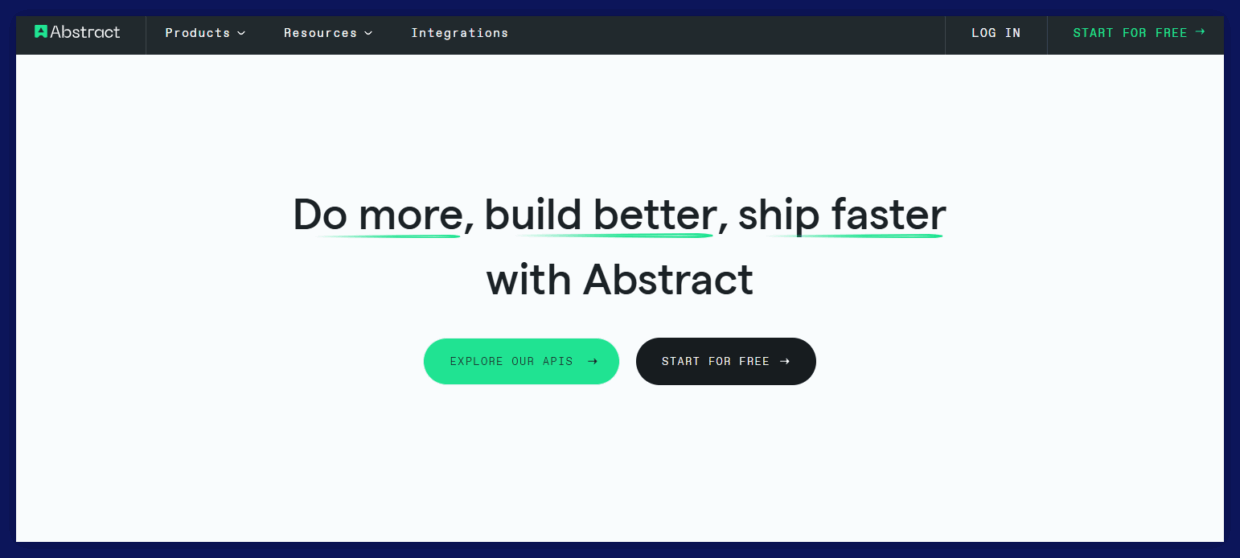
Abstract is a great entry-level API for developers and bootstrappers.
- Simplicity: Easy to get started, fast implementation, affordable for small volumes.
- Output: Covers validity, MX, disposable, but lacks deep deliverability/risk fields.
- Security/Compliance: Meets standard requirements, but less robust than Bouncer for enterprise needs.
- Integrations: No-code, Zapier, and direct REST API.
Target audience:
Small projects, prototypes, or personal use. Not recommended for high-volume marketing and sales teams needing advanced output or compliance.
Mailboxlayer API: Lightweight and affordable, limited for growth
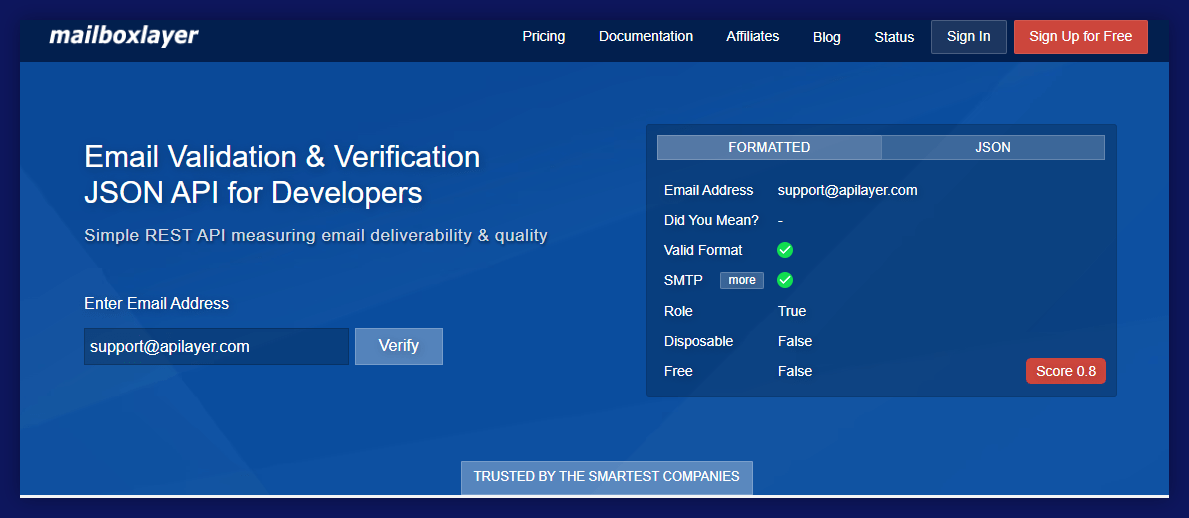
Mailboxlayer is popular for hobby projects, personal sites, and lightweight validation needs.
- Batch and single: Both endpoints provided, with quick responses.
- Output: Syntax, MX, disposable, but little enrichment or scoring.
- Security: Basic SSL, but not enterprise-grade data protection.
- Support: Ticket-based, not as hands-on as Bouncer.
- Pricing: Free tier, then pay as you go—very affordable for small lists.
- Limitations: Limited deep reporting, complex workflows for non-technical users.
Best for:
Startups, devs, or businesses just getting started and needing basic hygiene only.
The Bouncer advantage
All right… but why is Bouncer API really the solution you need? In what areas can it help?
Disposable email: The rising threat to data quality
Every month, new disposable email providers pop up, letting users bypass registration or grab freebies. If your API isn’t up-to-date, you’ll be fighting a losing battle:
- Disposable email address detection: Must-have for every API call, especially for onboarding and campaigns
- Automatic blacklist updates: Stay current as new providers emerge
- Flexible options: Flag, block, or suppress based on your workflow
Bouncer’s Toxicity Check stands out for speed, depth, and the ability to update rapidly, so you’re always a step ahead.
Email finder & validation APIs: Two sides of the same coin
For modern sales and marketing teams, combining an email finder with API-driven validation is a game changer:
- Find new leads, verify them instantly, and only keep valid email addresses
- Enrich CRM data and scoring with every call
- Bundle discovery, enrichment, and hygiene—no more siloed tools
Want to learn how Bouncer powers enrichment and validation in one flow? Check out Data Enrichment here.
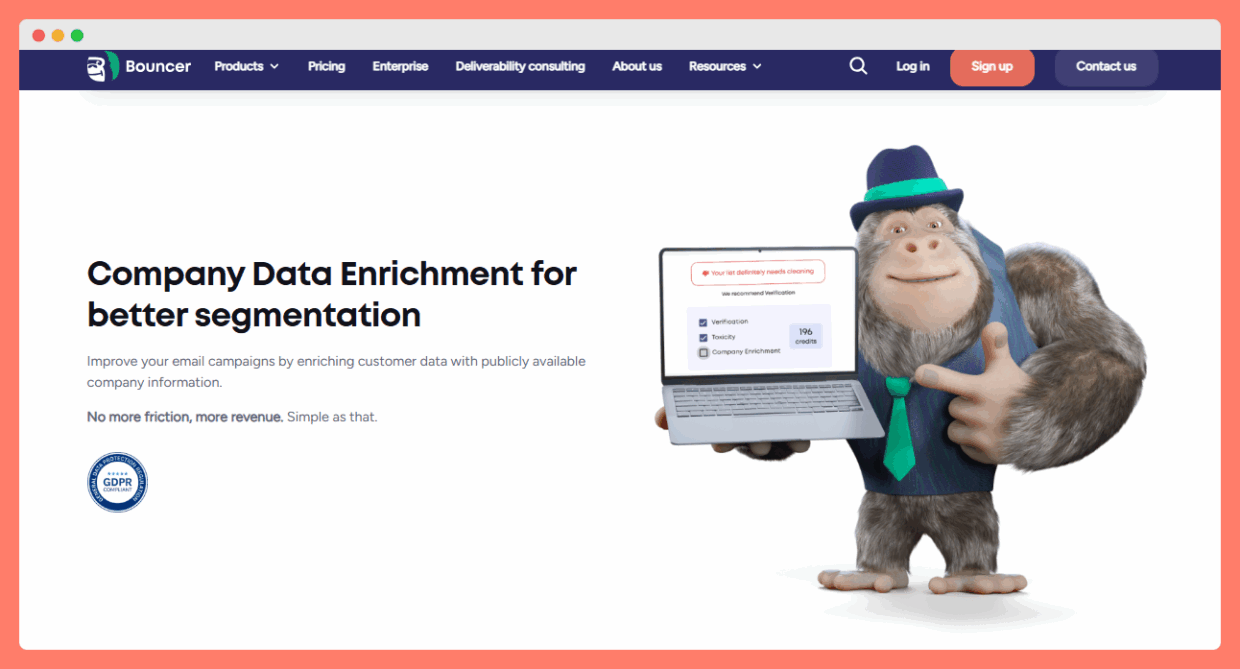
API documentation: The developer’s secret weapon
If you want adoption, nothing beats great docs. Here’s what separates the best:
- Clarity: Step-by-step, language-agnostic, clear error messages, and real use cases
- Sandbox/test mode: Safe playground for building and testing integrations
- Quick start guides: Sample scripts for batch, single, and webhook endpoints
- Support and uptime: Live status pages, API versioning, transparent rate limits
Bouncer’s API documentation is routinely praised for clarity, sample richness, and support—backed by a dev team that wants you to succeed.
Email reputation: Protecting your brand, deliverability, and growth
Email reputation is the sum of your hygiene, engagement, and compliance. APIs are central to:
- Maintaining low bounce rates with bulk email validation
- Monitoring blacklist status, complaint rates, and engagement with every campaign
- Ongoing hygiene—automate suppression lists and active risk management
The Deliverability Kit is a great next read if you want to own every piece of your reputation puzzle.
How to choose the right email verification API for your business
No two teams are the same—but the criteria are universal:
- Integration: Does it support your stack? Direct integrations, Google Sheets, Zapier, API endpoints?
- Pricing: Free credits, pay as you go, volume discounts, or custom enterprise? Transparent costs?
- Security: GDPR, military grade data encryption, auditability?
- Support: Fast, personal, and from people who know the product?
- Batch & real-time: Single, bulk, async, sync endpoints?
- API documentation: Easy for devs; great for non-devs?
- Output richness: Not just “valid”—get detailed risk, source, and deliverability fields.
- Reporting & dashboards: For compliance and ROI analysis.
Want a simple prep list? Download Bouncer’s high-season email checklist to cover every base before you switch.
Conclusion
Email is still king for marketing and sales, but only if your lists are clean, deliverable, and up-to-date. The best email verification software API is now essential for protecting your reputation, improving results, and scaling with confidence.
Ready to try a truly enterprise-grade API, with flexible pricing, top security, and developer-loved documentation? Then Bouncer is the answer.
Improve deliverability with Bouncer email verification.

FAQ: API email verification essentials
How does a real time verification API work for email addresses?
A real time verification API instantly checks each new email as it’s entered into your web forms, CRM, or product. It tests for syntax, domain validity, mailbox existence, spam traps, disposable email, and more—blocking or flagging bad data before it enters your system.
Can I bulk verify email addresses using an API?
Absolutely—bulk endpoints let you process thousands (or hundreds of thousands) of addresses per call. You’ll get detailed reports for each, including valid, invalid, disposable, and risk flags. See Bouncer’s batch capabilities here.
Is there a free version of Bouncer’s API?
Yes, you get free credits to test all API endpoints, plus a flexible pay-as-you-go model for scaling. Perfect for testing before committing to a monthly subscription or enterprise plan.
What does a good email verification API return for each address?
A robust API returns deliverability status, reason codes, mailbox flags (catch-all, role, full, etc.), risk/score, and source type (free, business, disposable). It may also provide enrichment info for CRM integration.
What kind of data protection regulations does a top API provider follow?
Leading providers (like Bouncer) are GDPR-compliant, use military grade data encryption, offer EU data residency, and let you anonymize or purge data as needed.
How easy is it to connect an API to Google Sheets or email marketing tools?
Very—Bouncer and others offer add-ons and pre-built connectors for Google Sheets, Zapier, and direct integrations with all major ESPs and CRMs. See Bouncer’s integrations for examples.
How does the API help with email reputation and deliverability?
By flagging risky, disposable, or undeliverable emails, you keep bounce rates down, maintain sender reputation, and ensure your messages reach real inboxes—not spam folders.
What support is available if I hit issues with my integration?
The best providers (like Bouncer) offer live chat, video support, detailed docs, and a customer success team that helps with every API request—from sandbox to production.

